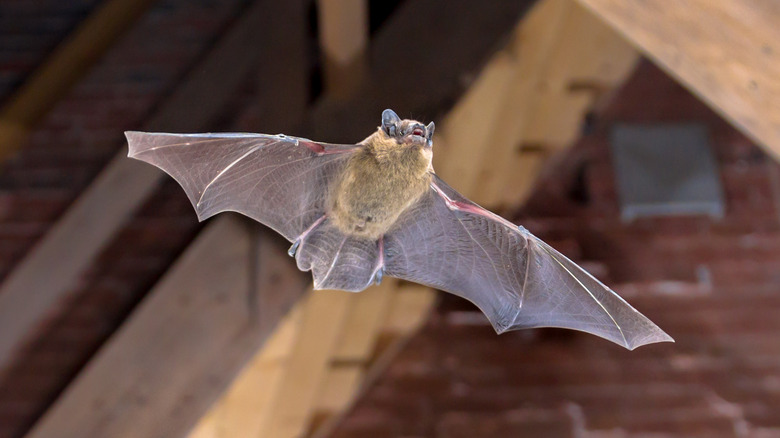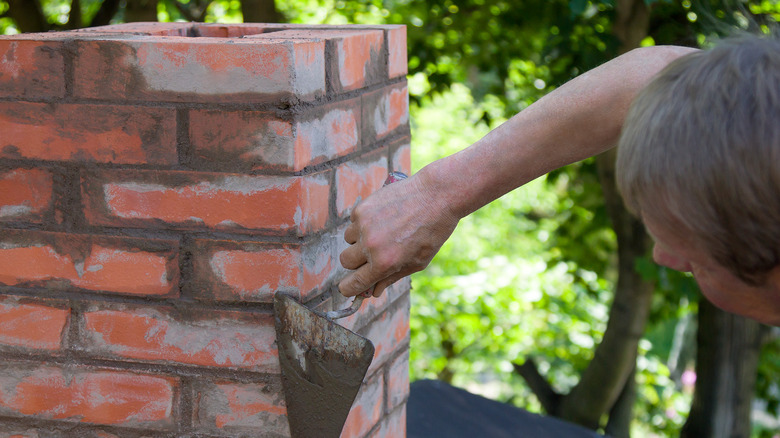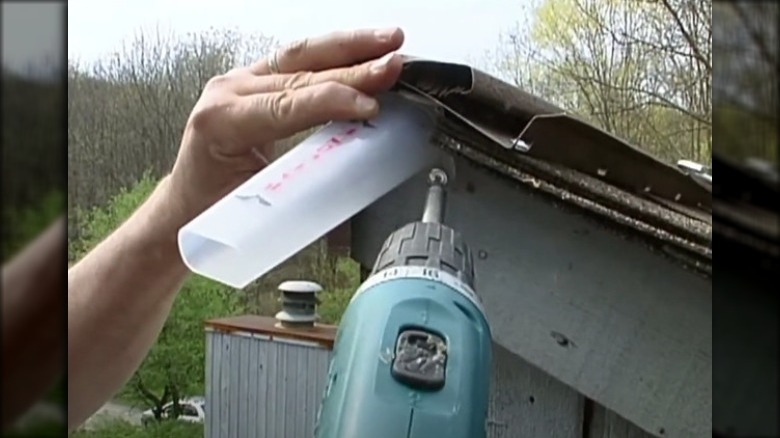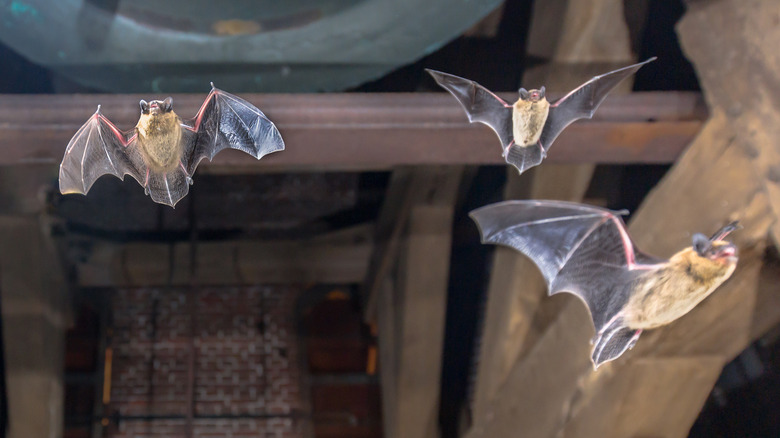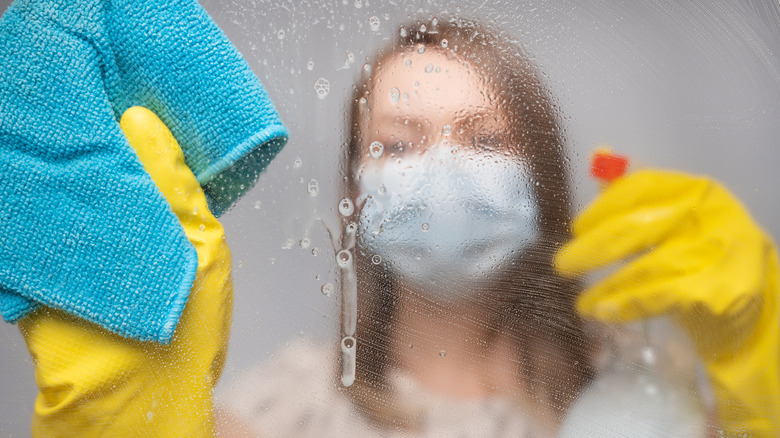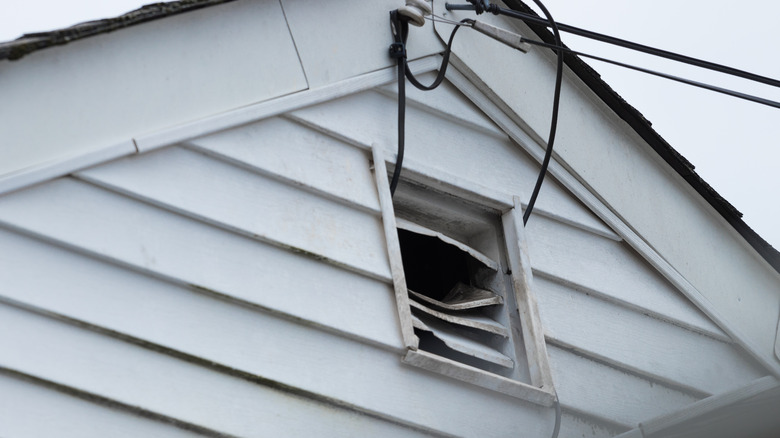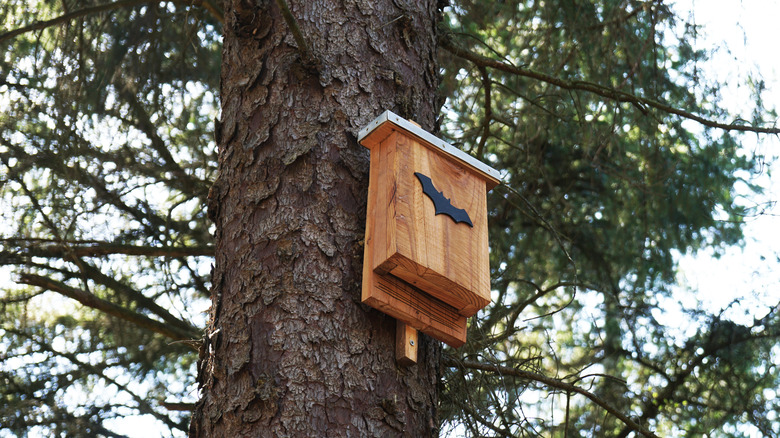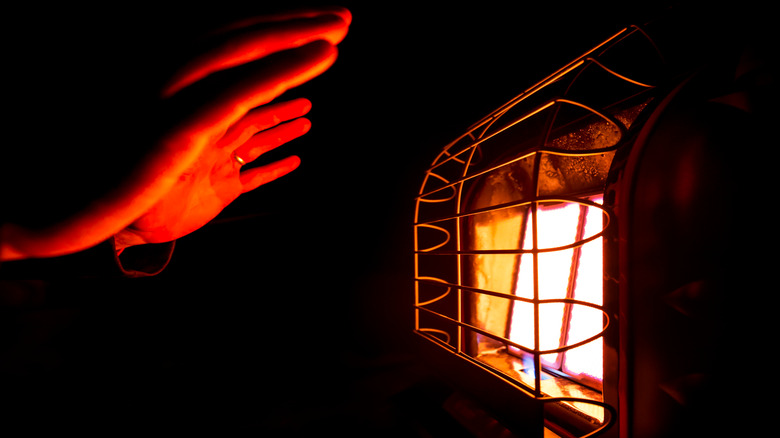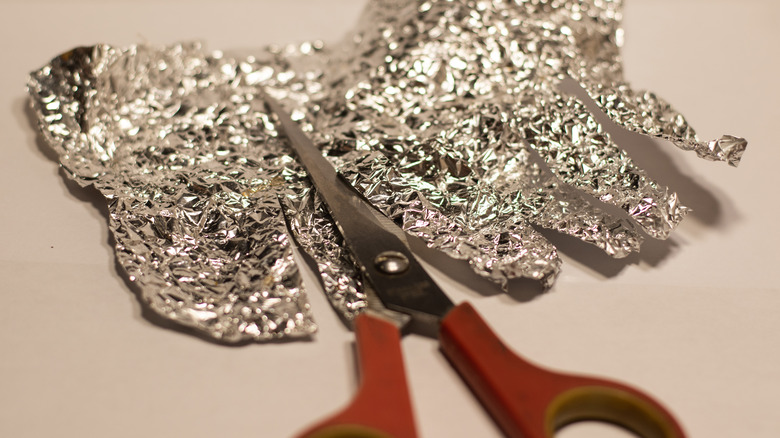10 Best Ways To Get Rid Of Bats In Your Attic
Not everyone is afraid of bats, but even if you don't mind (or even love) these particular nocturnal creatures, the fact is that they shouldn't be living in your attic. Just like other kinds of pests that could find a better home elsewhere — like rodents, flying ants, and spider crickets — bats can lead to issues that you definitely want to avoid. Skedaddle Wildlife points out that bats can cause minor annoyances like irritating noises, as well as major problems like causing health issues for you and your family due to diseases that can be present in the animals' poo (or guano), and the fact that bats can carry rabies. Bat poop can also harm your home itself, not to mention lead to some seriously disgusting smells.
If you suspect bats are living in your attic, Ontario Wildlife Removal suggests looking for things like black gunk (which is poo) around your home as well as stains and oily spots. Obviously, if you spot bats in the air, find a dead bat in your yard, or are given an, er, gift from your cat or dog that happens to be a bat that they've captured (ew!), then you might have bats in your home.
Once you've determined that bats have, indeed, gotten into your attic, there are a few things that you can do to get them out and force them to stay away. Read on to find out the best ways to get rid of bats.
1. Block the spots where bats are getting in
First and foremost, if bats have made their way into your home, then you'll need to figure out how they're getting in and do everything you can to make sure that once you get them out, they won't be able to return. You don't want all of your hard work to be for nothing, after all.
In order to do this, then you need to have a general idea of how bats find convenient entryways. Check your roof and siding for any holes and either patch them up or use screens to cover potential gaps. You should know that bats only need a 1/2 inch to squeeze into some spaces, according to Skedaddle Wildlife, so you'll need to address any and all potential spots no matter how big or small they might be.
Along with looking for cracks in the mortal, Varment Guard also notes that vents and chimneys provide bats with a safe tunnel into your home, so this is where you can use a screen in order to let the air out but not let bats in. Obviously, bats can easily fly quite high, so you may have to pull out a ladder or go out onto your roof to address any problematic area. Just be sure to be safe!
2. Bat cones
Once you've located where bats are getting into your home, you'll definitely want to block those spots as we've mentioned. However, if you suspect that there are still a few bats hiding in your attic and don't want to trap them inside, then you might want to use a bat cone.
Frontline Animal Removal explains that a bat cone is a device that is basically a simple tube made of plastic. It's installed in a spot where you know that bats are coming and going into your home. As the bats continue to use this entryway, the cone allows them to still get out, but they can't use it to get back in.
After all of the bats have left, then you can easily remove the bat cone and cover the opening in your house by either patching it up or putting up a screen as you did in all other places that were potential problems.
3. Bat flap
If you can't track down a bat cone that will work for your home, don't worry! A bat flap is a similar device that is meant to give you the same result. Bat Conservation International explains that a bat flap or valve is also installed at a spot where bats are known to be entering your house. However, inside of using a tube, in this case the valve is actually a flap — just think of it as a small door for bats that swings one way but not the other. Bats are able to get out by pushing the flap open, but they can't push it open the other way in order to get back in. Just like the bat cone, once the flap has done its job and the bats are gone, then you can remove it and cover the hole.
If you're worried that bats won't use the flap, Animal Remover points out that bats spend the daytime inside, but leave every night in order to find insects to eat. After they exit for their nightly meal through the flap, they won't be able to enter your home again.
4. Bat repellent
Once you've gotten the bats out of your attic, then you can take further steps to make sure that your unwelcome visitors don't come back. For instance, you can try using bat repellent. There are various products that you can opt for, with Pests.org suggesting copper mesh, bird spikes, and even an ultrasonic device that the bats can hear (Scientific American explains that while humans can only pick up sounds up to 20 kilohertz, bats' echolocation is in the range of up to 200 kilohertz). Beyond those devices, Pest Control Hacks also lists mothballs, a high-powered fan, and super-bright lights to make your home inhospitable to bats.
However, while plenty of companies and expert outlets suggest using a bat repellent, New England Today claims that an effective repellent for this sort of creature doesn't really exist if you're hoping for it to be a long-term solution. Instead, they note that repellents may work for a little while, but you'll still need a permanent way to fix this particular problem.
5. Clean up after bats
When bats move into your home, they don't concern themselves with being tidy houseguests. In fact, they can end up leaving an incredibly nasty mess behind. That's why Jim Dreisacker of Westchester Wildlife told This Old House that "it's not enough to remove the animal," you also "have to eliminate the odor." That's because getting rid of the smell isn't just a matter of making you and your family feel better — it's also an important part of keeping the bats from picking up the scent and attempting to return. It's also important to clean up after bats in a particular way.
Xtreme Cleaners suggests that you first keep yourself safe by suiting up in a mask (or anything that will cover your mouth and nose so you don't breathe in any nastiness), gloves (to protect your hands from bacteria and harsh cleaning products), and old clothes that you're willing to throw away. Then you don't want to pull out the vacuum or broom because you don't want to spread particles of potentially disease-ridden poop around while attempting to clean it up. Instead, carefully spray the affected areas with a water, hydrogen peroxide, and ammonia mixture to get any bat poo wet (we know this sounds gross, but it's the best way to avoid leaving bits of guano behind). Next, pick up any poo. Finally, clean the entire area thoroughly with your mixture before tossing away any towels, paper towels, or sponges that you used.
6. Keep up the 'bat exclusion'
The practices mentioned here are often referred to as "bat exclusion," and while they will help you get rid of the bats in your attic, it's best to keep up these practices if you don't want bats to return. That means continually checking out your home for new spots that could let bats in and making sure that areas that you've already addressed are still protected. Do you need to patch up a new crack in the mortal of your bricks? Do you need to replace a piece of mesh around a vent, a chimney, or a gap in the siding? Be sure to do so sooner rather than later.
On top of that, Pests.org points out that you'll want to avoid giving bats any temporary ways in, like an open door or screenless window. Just keep in mind the ways that you would keep annoying insects out of your home (especially at night) and the same goes for bats.
7. Hire a professional
If your attempts to get rid of the bats that have hunkered down in your attic have been unsuccessful, then it might be a good idea to hire a professional. It might also be your best option if going up against bats seems too overwhelming or simply freaks you out. Frankly, Wildlife Animal Control notes that making sure bats move out of your home isn't as easy as you might hope — and can even be risky — which is why it can be helpful to bring in people who have the proper know-how, right experience, and top-notch equipment, according to Edenic Homes Inc.
Professionals who deal in pest or wildlife control can help to determine how the bats are getting into your house, remove the pesky animals, and take the steps needed to keep them from getting back in. From there, you can hire a cleaning service that is willing and able to take on the kind of mess that was created while the bats were living in your home.
8. Bat house
What will happen to the bats that were living in your attic? You don't have to worry, because animals are incredibly skilled at finding places to live. However, if you want to make sure bats end up with somewhere to stay, then you can give them an even better place to live by setting up a bat house.
If you'd like to buy a bat house, then Bat Conservation International explains that it needs to be wood with no fabric or mesh, should offer the animals pads to land on as well as boards for staying comfortable, and it should be 24 inches high by 16 inches wide or bigger in order to be roomy enough yet stay at the proper temperature. If you'd like to make a bat house, Bat Conservation International also has designs for a four-chamber bat house and rocket boxes that you can download.
Where should you install your bat house? The National Wildlife Federation notes that it's best to choose a place that reminds bats of the kind of cozy space they'd naturally squeeze into, like the pocket between the outer bark of a tree and the tree's trunk inside. Bat Conservation & Management adds that your bat house should be in a spot that gets plenty of sun (around seven hours each day) and be high up off the ground (10 feet or more). Once you have the bat house in place, the animals can leave your house for good.
9. Raise the temperature to drive bats out
According to World Birds, bats typically prefer an optimal temperature range of about 80 to 90 degrees. Heating your attic to an uncomfortable temperature for your uninvited guests can make it inhospitable and help drive them out. You'll want to raise the temperature of the bat's nest to over 100 degrees to vacate them effectively.
However, heating your entire home to this temperature is unreasonable. Instead, utilize space heaters to safely and effectively increase the temperature within just your attic. First, you'll want to know the dimensions of your attic before heading to the hardware store. Purchase, rent, or borrow enough space heaters for the total square footage of the space. Strategically place them in the attic, turn them on high, and wait for the bats to vacate in a day or two (via Angi). Make sure to peek into the attic regularly throughout the process to ensure the heaters are still running properly and safely.
10. Use mirrors, foil, and light to deter bats
Electronic360 reports that bats are nocturnal and aren't big fans of artificial light. This is especially true when it comes to white and green-hued lights that tend to affect their behavior the most. Use this to your advantage and illuminate your attic with bright white or green colored flood bulbs. You can also use strobe lights pointed at the ceiling to create an inhospitable atmosphere for nesting (via Bird Sphere).
A large mirror can be used in combination with your light for maximum effect. Angle it so it shines upwards to deter bats from nesting in the ceiling. You can also strategically place small mirrors at entry points to discourage them from entering. Old CDs are great repurposed reflective surfaces that are simple to hang.
Another household item that can be used to get rid of bats is basic aluminum foil. This can reflect and amplify other light sources to create an unwelcoming space for nesting. These reflections will cause unpredictable flashes of light that bats don't like (via World Birds). Hang strips or balled-up pieces of foil from your attic ceiling. This has the added benefit of making noise that can act as a sound deterrent.
